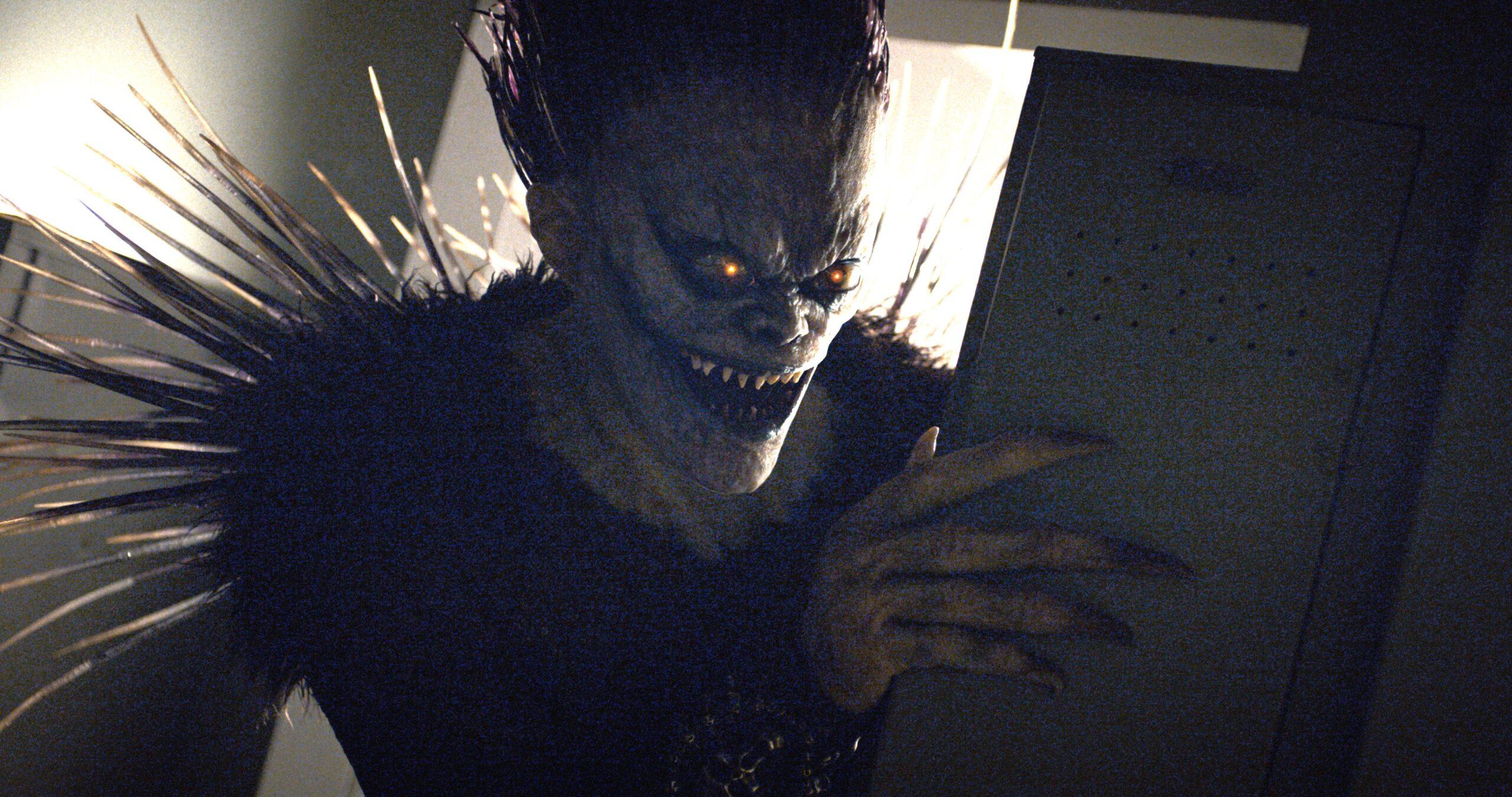As far as supernatural artifacts go, the Death Note is somewhat comically complicated to use, but it’s easy enough to explain. It’s a notebook. When it falls from the sky, it’s mostly blank, save for the first few pages, a user’s manual that lists the Death Note’s rules and morbid effects. If you, the owner of the Death Note, write someone’s full, legal name in the book and you’ve seen their face before, they will die. If you specify a time, the subject will die at the given time. If you list a cause or manner of death, the subject will die accordingly. In the original manga series, which ran from 2003 through 2006, as well as its popular anime adaptation, which aired on Japanese television from 2006 through 2007, the Death Note falls into the hands of a vengeful high school outcast named Light Yagami. Too bad for the thousands of personal rivals and criminal suspects whom he will go on to victimize, Light delights in testing the Death Note’s limitations. He’s a serial killer. He’s shameless, and he only occasionally pretends to use the Death Note for anything more than sport. Light Yagami is no hero.
Light is an altogether different character in the new Death Note movie, directed by Adam Wingard for Netflix. There’s already a Japanese series of live-action film adaptations, popular in its home market, which ages Light up a few years, places him in law school, and characterizes him as a reactionary tyrant. Wingard’s take stars Nat Wolff as Light Turner, a Seattle high school student, who goes by the pseudonym Kira for public relations purposes: He advertises his own crimes in order to make vague, convoluted points about law and order. (The movie isn’t totally clear on how, exactly, Light advertises Kira’s crimes.) Willem Dafoe plays Ryuk, the stalking “death god” who watches over Light. Lakeith Stanfield plays L, the special investigator assigned to track Kira down. L recruits Light’s single father, James, played by Shea Whigham, to assist in the Kira investigation, which is the earliest hint that Light may indeed be outmatched by an adversary more powerful than the death god in his corner.
First, it’s worth noting what Wingard’s take on Death Note gets right. The film’s opening 20 minutes summarize the manga’s key rules and lore with astounding confidence and efficiency: Light discovers the Death Note, he learns its power, and he then quickly puts that power to misuse. It’s quick and whimsical. There is no attempt whatsoever to render this story about a demigod teaching a high school boy how to murder people with a Trapper Keeper as realistic, or naturalistic, or plausible, or, worse yet, mature. Death Note is, for all intents and purposes, a CW drama, complete with a diverse, suburban high school and dim, fumbling teen romance. Light’s girlfriend, Mia Sutton, played by Margaret Qualley, occupies a great deal of screen time despite the script giving her very little to do apart from pecking Light’s cheek and cheering his killing spree. As Kira amasses a global cult of admirers, Sutton, the only other human who knows Kira personally, is simply his biggest fan.

But Stanfield, playing L, is Death Note’s biggest performance. L is a quirky, childish hermit—a hikikomori in the way of anime archetypes—but he is far wiser than his youth might suggest. Fueled by hyperactive curiosity and fistfuls of candy and other sweets, L quickly deduces clues to Kira’s age and whereabouts, though the film conspicuously rushes past any development that would lead anyone to observe a global pattern or deduce a single assailant in these murders to begin with. (In the original series, Light initially writes names in the Death Note immediately after school, which leads police to wonder why a spree of local murders is being carried out only at a specific time of day. Hence L’s intervention.)
In the anime, half of Light and L’s dialogue—and I really do mean half—is rambling, paranoid, internal voice-over speculation, quite like a soap opera. The Japanese and U.S. movies both strip that dramatic element from the story, but Stanfield compensates rather excellently in Wingard’s with fits of mumbled conjecture and gallows humor. On-screen, Stanfield’s strength is that he can maintain a certain acuity while hopping barefoot onto furniture in a colleague’s home and shoving pop rocks into his mouth. L is dramatic to the extreme, and Stanfield’s performance is a brilliant compromise between the boundlessness of cartoons and the constraints of physical comedy in a live-action drama.
The film’s central problem, really, is Light, who is too dull and unthinking to be truly persuasive as either vigilante hero or proper villain. If he’s ambivalent about killing supposedly bad people with impunity, you’d think he’d spend far more time weighing murder against his conscience. If he’s evil, you’d think he’d spend far more screen time celebrating the Death Note’s revolutionary potential. Light Turner, as played by Wolff, does neither. He seems to murder people because, and only because, a script requires him to do so. He’s never characterized as an exceedingly vindictive person. At his high school, he’s enough of an outcast to walk through each hall and classroom without a friend in sight. But later, Light Turner is so seductively witty and arrogant, especially once he’s acquired the Death Note, that he instantly charms the first (and only) girl the camera ever settles on. Light is enough of a sociopath to use the Death Note, without hesitation, to murder random criminal suspects across the world; but then he regularly interrupts Sutton’s passionate embrace to stress, “We don’t kill innocent people.” It’s a vague metaphysics. There’s no rhyme or reason. And since there’s no coherent ideology, however reprehensible or even ridiculous, there’s no exact, captivating character at the heart of Light’s actions.
Light’s ambivalence aside, there are also some insurmountable problems with the movie’s pacing and scale. Reducing a serialized manga plot to a 100-minute film runtime is thankless butchery, and really no one alive, not even Christopher Nolan, has truly mastered that art of adapting comics. The Death Note movie constrains itself to the most popular narrative thread of the original series, the relationship between Light and L, but the latter’s investigation of the Kira murders sparks no real rivalry with the former. In the original series, Light and L share many tense scenes together, and their staredowns are filled with patient hatred and palpable conflict. In Wingard’s movie, Light and L share one key scene for all of 90 seconds before the story devolves into one long foot chase. (In fact, that scene is the film’s latest trailer.) Here, it’s no longer a story of fated rivals, but a very obviously inevitable arrest. The tone and setting may be the stuff of CW teen dramas, but Wingard’s execution is more so in the spirit of Law & Order: Criminal Intent (Stanfield being D’Onofrio in this case).
There’s much to love about Stanfield’s performance as L, and a lot to be desired from Wolff as Light. Regardless it is generally regrettable that more of these roles, in more of these projects, which pillage manga and anime classics, don’t call on Japanese actors to suit the material. It is also unfortunate that relatively few potential fans in the U.S., including critics, who criticize Western anime adaptations for their non-Japanese casting will bother to watch and review the live-action adaptations that Japanese studios produce, as they do indeed star Japanese casts. (Admittedly, these movies can be somewhat difficult to stream or acquire.) Upon the release of the first trailer for Wingard’s film, critics took Wingard’s adaptation to task for reimagining Light Yagami as white and relocating the story from Japan’s Kanto region to the Pacific Northwest. Paul Nakauchi plays L’s mysterious assistant, Watari, and there’s a brief cameo from Masi Oka, better known as Hiro from Heroes. As a preemptive compromise with critics of Hollywood whitewashing, these tertiary castings are half-baked and unsatisfying, especially in a movie that struggles to do even its principal characters justice.
Narratively, though, there’s no reason this sort of live-action adaptation shouldn’t entertain someone, anyone, be they an anime fan seeking a reasonably faithful adaptation or a newcomer just looking for a cool, dark fantasy. The original Death Note is simple enough. In both manga and anime form, Death Note is a late genre classic, but it is not some radical artwork that defies easy Western translation, or even comprehension; both the manga and the anime series are populist favorites among anime fans worldwide. Essentially, Death Note is a serialized detective drama in which two strange wise guys face off to prove their superior wits. It’s not that deep. And, in fact, it’s the supernatural elements that Wingard presents with utmost contempt for fans’ possible disbelief, a confidence that live-action anime adaptations require. It’s confounding, then, that Wingard stops short of trusting his audience to embrace the original Light Yagami, a moody serial killer, as a protagonist, and instead sticks us with a rudderless romantic who is somehow even harder to love. Light Turner has a name and a face. If the Death Note fell in my lap, I’d pencil him in first.
